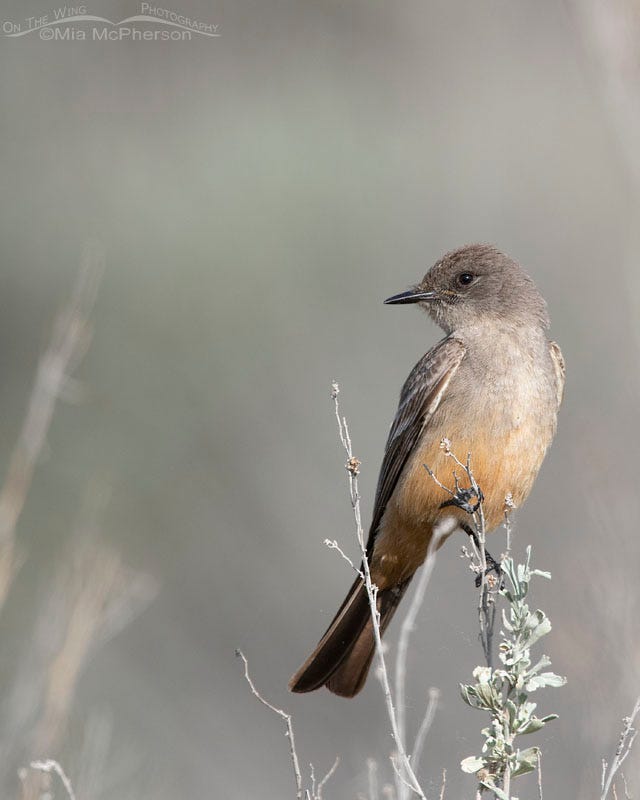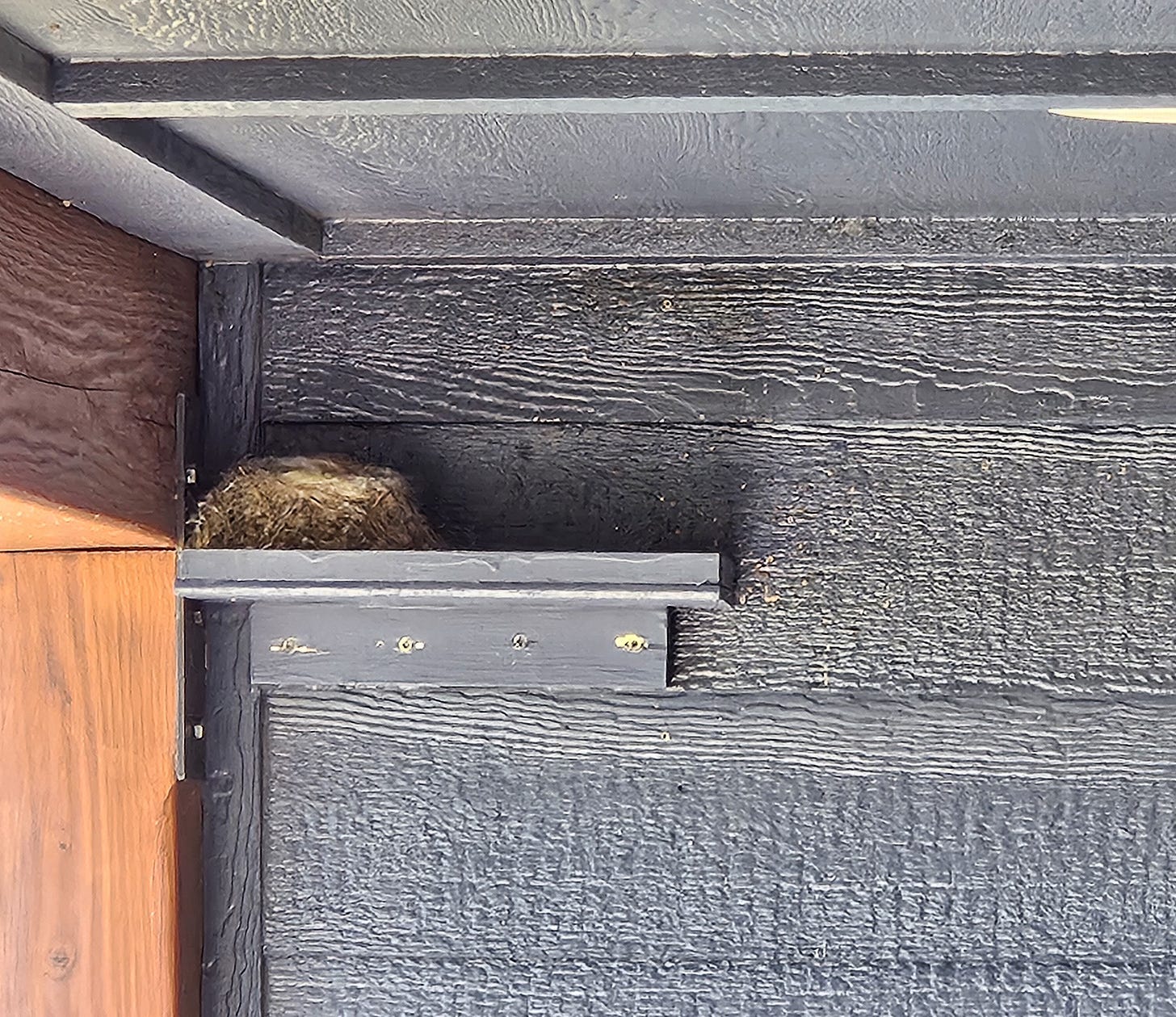
My newest nearest neighbor
For more than a decade, a sweet mournful whistle has been one of my earliest indications that spring is tapping at winter’s icy margins. Each year, I look forward with great eagerness to the moment when I first hear that haunting pit-seew ring out on an early March morning. And then, in 2023, I didn’t hear that much-anticipated call.
The subtly beautiful Say’s Phoebe—with its gray breast, cinnamon belly, and long black tail—is one of the first migratory birds to return to my property each year from its winter haunts. Its early return is remarkable given the bird’s dependence on insects for food. But the phoebe’s willingness to pluck invertebrates like spiders and beetles off the ground may help it survive cold, snowy spells when flying insects are scarce. Indeed, the Say’s Phoebe occurs farther north (into northern Alaska) than any other North American flycatcher.
One of only three phoebe species in the US, the Say’s Phoebe inhabits arid, open country from the Great Plains west almost to the Pacific Coast. Like the better-known Eastern Phoebe, it is often found in close association with people, flitting around our rural homes and outbuildings. Both phoebes nest on sheltered ledges, and I was thrilled, years ago, when a pair of Say’s Phoebes nested under the eaves of my Wyoming house. Watching the birds raise young for two summers before I returned to Montana was a delight—a window of discovery into an unfamiliar species.
So when I learned in 2023 that one of my neighbors wanted to rid herself of Say’s Phoebes that had nested under the eaves of her porch, I was floored. The bird whose absence from my property was causing me such distress was nesting up the road, where it was unwanted. Ironically, I’d spent the previous four years trying to tempt phoebes to nest on my own house. First, I’d attached a ledge to a sheltered side of the house, but the platform had been too exposed. The next year, I’d put a roof and sides on the ledge, but still the phoebes shunned it. The following year, I’d purchased two nest boxes that the manufacturer claimed were made especially for Say’s Phoebes, and placed them under my eaves. The birds barely spared them a glance. And now my neighbor was decrying the mess that fledgling phoebes were making on her porch, while my home echoed with the phoebe’s absence.
The lack of phoebes on my property (along with a lower number of bluebirds) fueled my eco-anxiety, since the birds’ disappearance seemed like the visible manifestation of the alarming losses (an estimated 3 billion birds) that scientists have documented in North America over the last 50-years. The practical biologist in me knew that environmental factors could cause year-to-year fluctuations in bird numbers and it was long-term trends that were meaningful. But that knowledge did little to allay sleepless nights. And although numbers of all three phoebe species appear to be stable, populations of many other insectivorous birds have declined steeply.
To my relief, in March 2024, that inimitable phoebe whistle rang out from my rooftop. And at long last, a pair of Say’s Phoebes seemed interested in one of my nest boxes. Its location, tucked up under my back porch, appeared to be perfect. But its design was not. The phoebes shunned its too-small interior and clung to its slanted roof. Glancing up from my desk, I could watch the pair’s activities through my office window. The birds paid me no attention. When the female brought in a few grass stems and I watched them slide off the box’s sloped roof onto my deck, I realized that my box offering was inadequate. Removing the box, I replaced it with a flat ledge. And finally, after five years of failure, I was rewarded by the busy nest-building activities of a female phoebe and the somberly elegant presence of her attendant mate.
My female phoebe is now incubating four eggs, and her comings and goings are a constant fascination. I’ve learned that the pair trills whenever they are at the nest together and that the female takes more incubation breaks than I expected. Among my greatest pleasures while working as a wildlife biologist was sitting in blinds, watching wildlife go about its daily life without being influenced by my presence—the way I’m now doing with my phoebes. Most wild animals flee from us, hide from us, avoid us. But the confiding phoebes bring the wild to our doorsteps, raising their young in our midst—if we let them. To me, that’s worth a little accommodation—and a lot of celebration.
Take a small step to help birds
It is easy to feel helpless in the face of climate change, habitat destruction, and disappearing wildlife. But according to the US Fish and Wildlife Service, over 96 million people in North America watch birds. If each of us does something to help them, we may be able to reverse their declining numbers.
Here are a few things you can do:
Tolerate a little mess, if you can. You’ll help birds by allowing them to nest on your house or by allowing the corners of your yard to grow wild, which provides habitat for insects.
The widespread use of pesticides is contributing to the dramatic disappearance of insects. Limit the use of pesticides around your home to foster insects and protect your resident birds from harm.
Consider adding some native plants to your landscaping. Doing so supports insects, which are essential food for our insectivores and for the many other birds that feed insects to their young during the breeding season.
Keeping our cats indoors helps prolong their lives and keeps our neighborhood birds safe.
Thank you for reading and thanks for all you do to help birds!
Until next time …
P.S. Thank you to friends old and new, from all around the country, who sent me photos of their copy of my new book Feather Trails—A Journey of Discovery Among Endangered Birds when they received it!





How wonderful it will be to see the hatchlings and then the fledglings! The small steps to help birds are so important! I cringe when I see what much of our culture defines as a "perfect" lawn. As Hopkins wrote, "Long live the weeds...." And thanks for including the importance of keeping cats inside--or in a catio!
Loved this one Soph!! ❤️